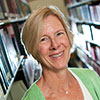This article is more than 5 years old.
SustainRT Indianapolis Canal Walk Tour
Both Friday and this morning were filled with still more session opportunities than you could shake a stick at! Yesterday morning I decided to think about things digital, so started out at a session conducted by staff of Columbia University Libraries entitled “Building the future: Leveraging Building Projects as Platforms for Organizational Change.” Back in 2005-2006 they envisioned 3 different Digital Centers (Humanities, Social Science and Science) that would be aligned with research and graduate study. To that end they made it part of the strategic plan and funding was found (best quote was attributed to James Neal: “If you want to see a library’s strategic plan, look at their budget.”). The centers have been implemented and the presentation covered planning/assessment, understanding user needs, changes in staff roles, training, culture changes for IT, etc..One report they recommended is “Re-skilling for Research” (2012) that looks at the roles and skills of subject and liaison librarians needed to support the evolving research needs of researchers.
Next up was a panel discussion on data curation that brought together 3 organizations at different stages of providing data management services. The session was “Wading into the data pool without drowning: implementing new library data services” using the swim metaphor to talk about one program at James Madison that in its infancy (testing the water), one that is plunging in (Penn State), and one that is the most advanced (Cal Poly) and thus is in the water and “Learning to Swim.” All took a case study approach and shared the steps they are taking to support faculty. The overall message was is that providing these services is not a sink or swim proposition. Just consider where you are and where you’d like to be to build a program at the level and pace that works for your institution.
In the afternoon, I switched gears to the assessment track. I’ll let Mary Beth report on the update given on the ACRL Value Project which we hope to participate in during year two. After that session, I ended the day by attending a session on qualitative research methods (I love qualitative research, btw): “Inspiring Initiatives in Qualitative Inquiry.” I heard about 3 different qualitative research projects – a focus group study (OCLC), an ethnographic study using photo study and immersive observation (at UNCC by their anthropologist who works at the library but is not a librarian. The library is her fieldwork), and one that used the critical incident technique (Rutgers). This last methodology was one with which I was unfamiliar but it sounds like a most interesting approach. It is used to study effective and ineffective behavior and focuses on most memorable event/experience of participants. You ask just two questions: “What did you liked best about (fill in the blank) and can you tell me exactly why?” and then, “What did you like least about (fill in the blank) and and can you tell me exactly why?” (OK, maybe that is four questions if you don’t compound them…..).
After a full day of sessions, it seemed like a no-brainer to join in on Beth Filar Williams’ SustainRT walking tour of downtown Indianapolis. She organized it and arranged for a local public librarian to be our tour guide. I got a chance to see a few sights, take a few photos, and make some new friends, in spite of freezing in the brutally windy 40-some degree weather with no coat or gloves! The picture at the top of this post is the hardy group of librarians who braved the cold to see the sights!
Today, I closed out my conference by attending two future -looking sessions. The first, “Think like a startup: creating a culture of innovation, inspiration, and entrepreneurialism,” was a panel discussion that offered case studies and “best practices” that included “fail faster” (don’t waste time on things that don’t work)! I heard a new term in this presentation: The T-Shaped Employee. The image showed uses a man’s figure standing in a T to illustrate breadth vs. depth of expertise. It also was the first time I’ve heard about the California Digital Library project, DataUp, where Microsoft developed an Excel addin/web-based way to help researchers manage their data. In the final session of the day, 3 more contributed papers were presented (and I’ll let you read them for yourselves!): Transformation Begins When Renovation is Done: Reconfiguring Staff and Services to Meet 21st Century Research Needs, Reorganizing the Distributed Library, and What Will Libraries Be When They Grow Up?: Responding to the Innovations of Technology and Imagining the Future.
I’ll also let another of our group tell you about the final keynote by NPR’s Maria Hinojosa because I’m sure they can do it more justice. But, as with the other keynotes from this conference, it was very powerful and thought-provoking. The gist of her message came (for me) in her question to us: Can you see yourself in me, and I in you?


4 Comments on ‘Susan: ACRL 2013 Wrapup’
Great post and great pics! I really like the idea of asking just two questions:
“What did you liked best about (fill in the blank) and can you tell me exactly why?” and then, “What did you like least about (fill in the blank) and and can you tell me exactly why?”
I’m going to use those!
No wonder you are tired!
Good post, Susan. I hope your hands are now completely warmed up.
Thanks for the links to “Re-Skilling…” and the other papers — I used them.